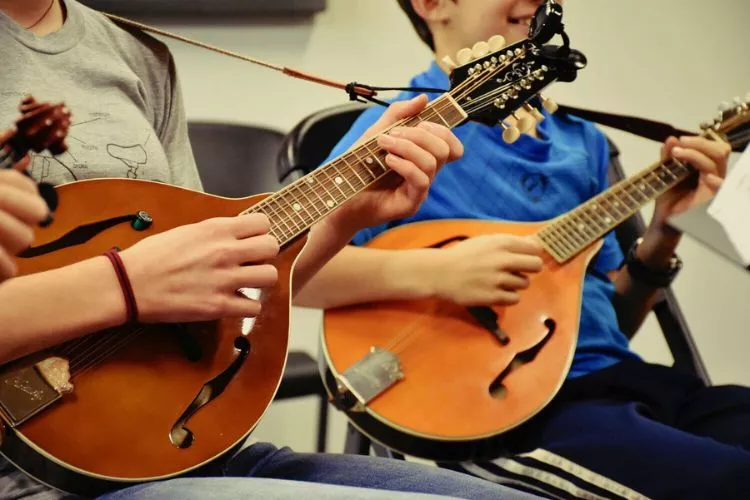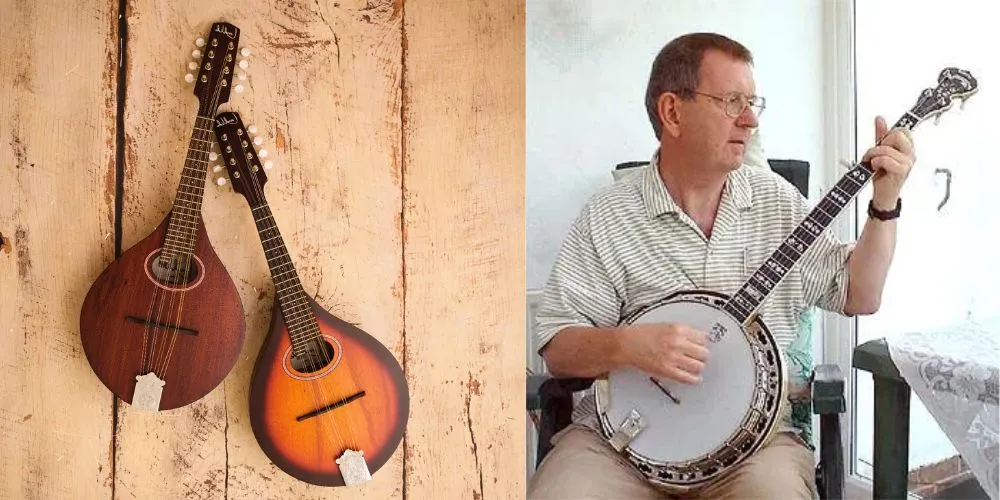The mandolin and the banjo stand proudly in stringed instruments with their distinctive sounds and intriguing histories. That’s why the “mandolin vs banjo” debate is widely popular for decades.
Often seen in the hands of bluegrass, country, and folk musicians, these instruments have deeply influenced many music genres worldwide.
While they may seem similar at first glance, the mandolin and the banjo each offer a unique auditory experience that sets them apart.
Their sound and structure are the most significant difference between the mandolin and the banjo. With eight steel strings tuned in pairs, a mandolin produces a sharp, bright melody.

On the other hand, the banjo, which typically has four or five strings, generates a distinctive, resonant twang due to its drum-like body.
The difference in tonal quality between these instruments profoundly impacts the genres and styles of music they are commonly used in.
🎶Mandolin vs Banjo: What’s the difference?
The mandolin, originating from the lute family, can be traced back to the early 17th century in Italy.
Various regional specificities and designs marked its evolution, but the Neapolitan mandolin and its eight-stringed, teardrop-shaped form truly captured the public’s attention.
The mandolin’s unique sound and captivating history led to its incorporation into various styles of music, ranging from classical and operatic pieces to folk music and bluegrass.
The banjo’s roots can be traced back to West Africa, where its precursor—the akonting—was played as early as the 13th century.
Brought to the Americas during the colonial era through the African diaspora, the banjo’s design evolved as it intertwined with other musical traditions.
The contemporary banjo of today, with its distinctive drum-like resonator and fretted neck, is largely influenced by African and European instruments.
Now let’s dig deep into the mandolin vs banjo discussion.
Anatomy and Construction
The Mandolin: Precision in Design: The modern mandolin is a wonder of precision design. This small-bodied instrument typically has a pear-shaped, arched-top body, a neck fitted with frets, and a walnut, rosewood, or ebony fingerboard.
The mandolin most commonly features a set of eight strings – two for each of its four courses (G, D, A, and E). These strings are usually tuned in unison to produce their bright, ringing sound.
Materials used to construct a mandolin often include:
- Spruce for the top.
- Maple for the back and sides.
- Rosewood or ebony for the fingerboard.
The quality of these materials, coupled with the skill of the luthier (a person who makes or repairs stringed instruments), plays a significant role in the instrument’s tonality.
Mandolin playing techniques can vary based on the style of music, but generally, they are played by plucking or strumming the strings with a pick.
To create different notes, the player presses down on the strings at different frets with their fingers.
The Banjo: Robust and Resilient: Unlike the mandolin, the banjo features a drum-like body called a pot, upon which skin or synthetic head is stretched. This design is responsible for the banjo’s unique, resonant sound.
The banjo typically has four or five strings stretching over a bridge to a tailpiece, tuned via pegs at the top of its fretted neck.
Banjos are traditionally constructed using a combination of wood and metal. The pot assembly often consists of a metal rim (often brass or bronze) and a tone ring, which can greatly influence the instrument’s sound.
The banjo is played in various ways, depending on the style of music and the personal preference of the player. Some banjoists use fingerpicks and play using a “roll” pattern, which is prevalent in bluegrass music. Others may choose to strum or fingerpick without any picks at all.
Understanding Construction and Play: Undeniably, the differences in physical attributes, design, and historical influences between the mandolin and the banjo contribute not only to their unique sound qualities but also to the ways they are played.
These instruments embody complex blends of historical, cultural, and musical context within their structures, reflecting the rich tapestry of their respective evolutions and usages.
Sound and Tone
The Mandolin: Bright Elegance: The mandolin is renowned for its bright, sharp, and resonant tones, emanating an aura of elegance and precision.
Its high-pitched tone, achieved by tuning the pairs of strings in unison at high tension, allows for quick notes and intricate riffs that project clearly and stand out in arrangements.
The arched top and back of the mandolin contribute to its punchy, sustained sound, making it ideal for rhythmic chording and virtuosic soloing.
The Banjo: Distinctly Americana: With a sound as rich as its history, the banjo’s tone is unmistakable. Known for its loud and resonant timbre, the banjo’s bright, twanging notes give it its signature bluegrass sound.
However, the sound can change significantly based on the type of banjo and playing style. For instance, a resonator banjo is louder and projects forward, making it ideal for bluegrass and ensemble playing.
On the other hand, an open-back banjo has a quieter, mellower sound, perfectly suited to old-time or clawhammer styles.
Sound Range and Flexibility: Despite the varying timbres, both the mandolin and banjo boast a high degree of flexibility regarding their sound ranges.
The four-course, eight-string design of the mandolin allows for a wide variety of skillful note combinations in its relatively high register.
With the ability to play chords, melodies, and tremolo, the mandolin can perform various musical tasks.
The banjo also offers flexibility. It is basic four or five-string forms can produce a deeply resonant and pliable tone for a wide range of pitches.
The mechanics of the banjo’s drone string bring a unique rhythmic and tonal element to its sound, adding to the instrument’s versatility.
Music Genres and Styles
The Mandolin: A Versatile Virtuoso
Its bright, clear sound and accessibility make it a popular choice in various music styles. It is often associated with:

- Classical: Classical mandolin music dates back hundreds of years, featuring complex pieces by Vivaldi and Mozart.
- Bluegrass and folk music: The mandolin’s high, bright sound naturally fits into bluegrass’s lively string ensemble. Important figures include Bill Monroe, often considered the father of bluegrass.
- Rock and pop: Artists like The Beatles and R.E.M. have infused the mandolin’s unique sound into their music, illustrating its versatility.
The Banjo: A Cultural Synthesis
Known for its characteristic twang, the banjo is prominent in:

- Bluegrass music: The banjo is a bluegrass staple with its vibrant, energetic sound and complex picking styles. Players like Earl Scruggs greatly shaped the genre.
- Folk and country music: The banjo’s rich, warm tone is commonly featured in these genres, often providing rhythmic support or stirring solos.
- Jazz and Ragtime: The banjo’s lively and bright sound allows it to seamlessly integrate into these genres. Key figures include musicians like Johnny St. Cyr in early Jazz bands.
Musical Greats and Their Instruments
While these instruments are associated with certain genres, they’ve been deftly handled by musicians across all styles.
Mandolin virtuosos include Chris Thile, Caterina Lichtenberg, and the late David Grisman, renowned for their exceptional skill and contributions to music.
On the banjo side, the legendary Earl Scruggs, Béla Fleck, and Noam Pikelny have notably pushed the boundaries of banjo playing. The choice between a mandolin and a banjo could fall to a preference for a particular type of music.
However, given their extensive and diverse use by musicians, deciding between the two can often be a highly personal choice.
These instruments are not limited to their standard genres but are instead open to vast possibilities, driven by the creativity and passion of the player.
Pros and Cons
Both the mandolin and the banjo require a commitment to master. The mandolin’s small size has advantages but becomes more challenging when tackling advanced techniques.
Meanwhile, the banjo’s distinctive sound can be easier to achieve initially, but complex fingerpicking patterns take time and effort to perfect.

Ultimately, the choice between the mandolin and the banjo comes down to personal taste, musical interests, and the time spent honing your skills.
Each instrument offers a unique musical journey with joys and challenges that will shape your musical development.
The Mandolin
Pros
✅ Portability: Mandolins are small, lightweight, and easy to transport, making them an excellent choice for musicians on the go.
✅ Versatility: The mandolin’s bright, ringing sound can be adapted to fit various genres, from classical to rock.
✅ Learning Curve: The compact size and relatively narrow fret spacing make it easier for those with smaller hands to manage. Basic chords and strumming techniques are simple to learn.
Cons
❌ Cost: High-quality mandolins can be expensive, but there are also affordable options for beginners.
❌ String Tension: The high tension of the strings may cause discomfort for beginners during initial practice sessions.
❌ Skill Level: While easy to start, mastering advanced techniques like tremolo picking takes considerable time and practice.
The Banjo
Pros
✅ Distinctive Sound: The banjo’s twangy, rhythmic sound makes it a standout choice for those seeking a unique musical voice.
✅ Adaptability: Banjos can be played in different styles, such as clawhammer or fingerpicking, across genres like bluegrass, folk, and jazz.
✅ Beginner-Friendly: Basic banjo techniques are relatively easy to learn, making it an accessible instrument for new players.
Cons
❌ Cost: Like mandolins, high-quality banjos can be expensive, but beginner options are cheaper.
❌ Size and Weight: Banjos with resonators can be heavy, making them less portable than mandolins.
❌ Complex Techniques: Developing intricate fingerpicking and roll patterns for advanced banjo styles demands considerable practice and dedication.
🎶Frequently Asked Questions (FAQs)
Answer: The ease of learning mandolin or banjo depends on individual preference and musical background. The mandolin’s compact size and narrower fret spacing might be easier for people with smaller hands, and initial chords and strumming techniques are simple to learn. The banjo has a more distinct sound, which can gratify beginners. Basic banjo techniques are also accessible to new players. Ultimately, personal learning styles and interests determine which instrument is easier to learn.
Answer: The banjo and mandolin do not share the same tuning. The mandolin typically has eight strings, arranged in four pairs (or courses) tuned to G, D, A, and E, with each pair sharing the same pitch. The banjo commonly comes in four-string or five-string configurations, with different tunings depending on the style. A standard five-string banjo is typically tuned to G, D, G, B, and D, with the fifth string being a high G drone.
Answer: Mandolin and banjo chords are not the same due to their different tuning and string configurations. Though some chord shapes may have similar finger positions, the actual chords produced will differ between the two instruments. Consequently, transferring chord shapes from one instrument to another requires understanding their respective tunings and chord structures.
Answer: While the mandolin and banjo are stringed, plucked instruments, they have distinct playing techniques due to their differing construction and tuning. It is possible to apply some banjo techniques, such as rolls, to the mandolin; however, the result might not sound the same due to its unique tonality and string arrangement. Adapting playing styles across instruments usually involves creative experimentation and understanding each instrument’s characteristics.
Conclusion:
In the musical world of stringed instruments, both the mandolin and banjo hold their unique places. Each instrument has distinct sound characteristics, associated genres and styles, and unique pros and cons.
With its sharp, clear, high-pitched elegance, the mandolin fits beautifully in classical, bluegrass, and alternative rock music. On the other hand, the banjo brings a twangy, rhythmic pulse that’s become the heartbeat of bluegrass, folk, and country music.
Each instrument’s learning curve, playability, and costs offer challenges, rewards, and differing skills required to master them.
Despite these differences, they are both highly versatile, offering a broad range of tonal variety extending beyond their most recognized genres.
Ultimately, the choice between mandolin vs banjo comes down to personal preference, influenced by your musical aspirations and the sound that resonates most with you.
Whichever you choose, the mandolin and banjo serve as wonderful conduits for the language of music, each providing a unique voice and enriching our collective soundscape.
